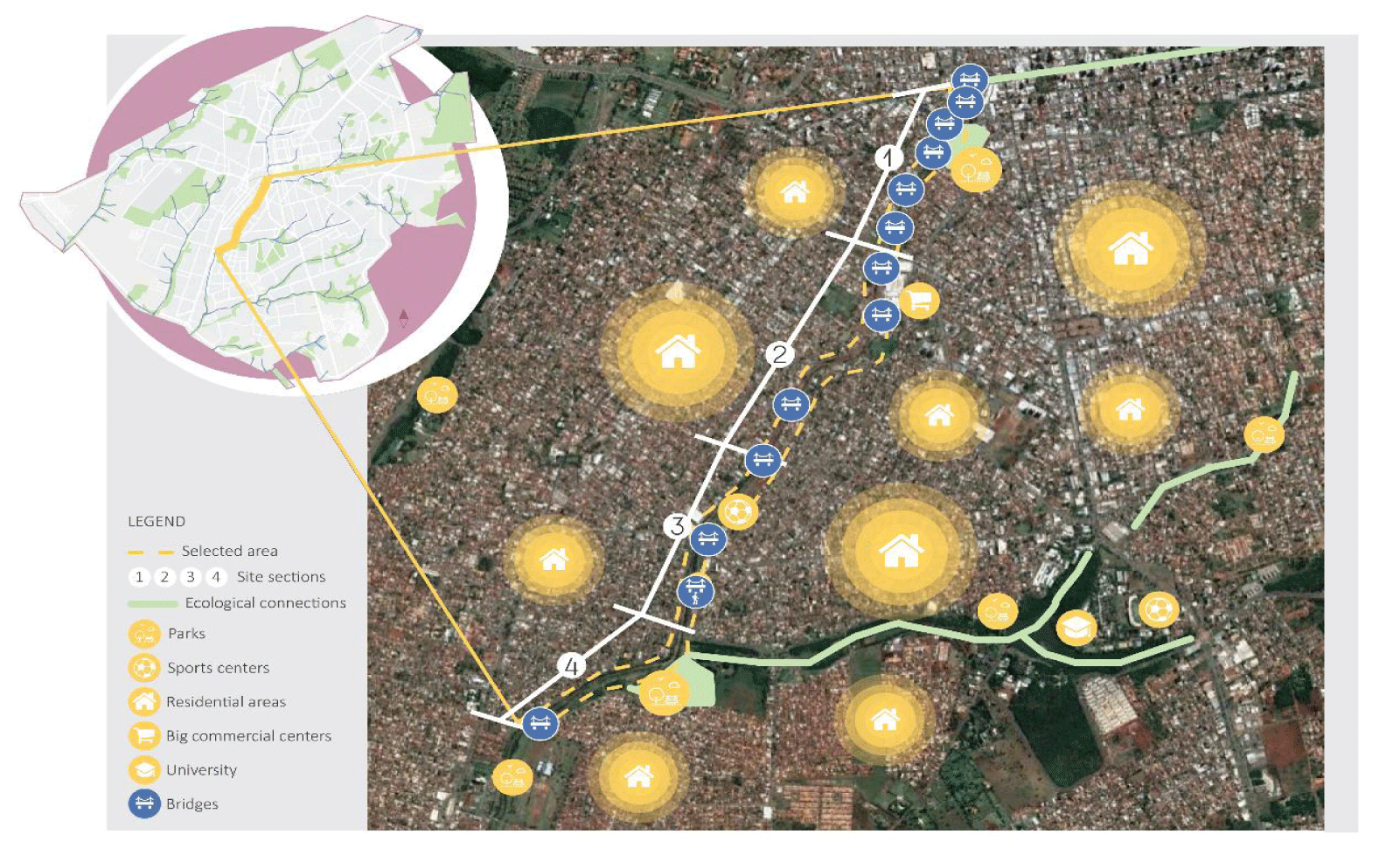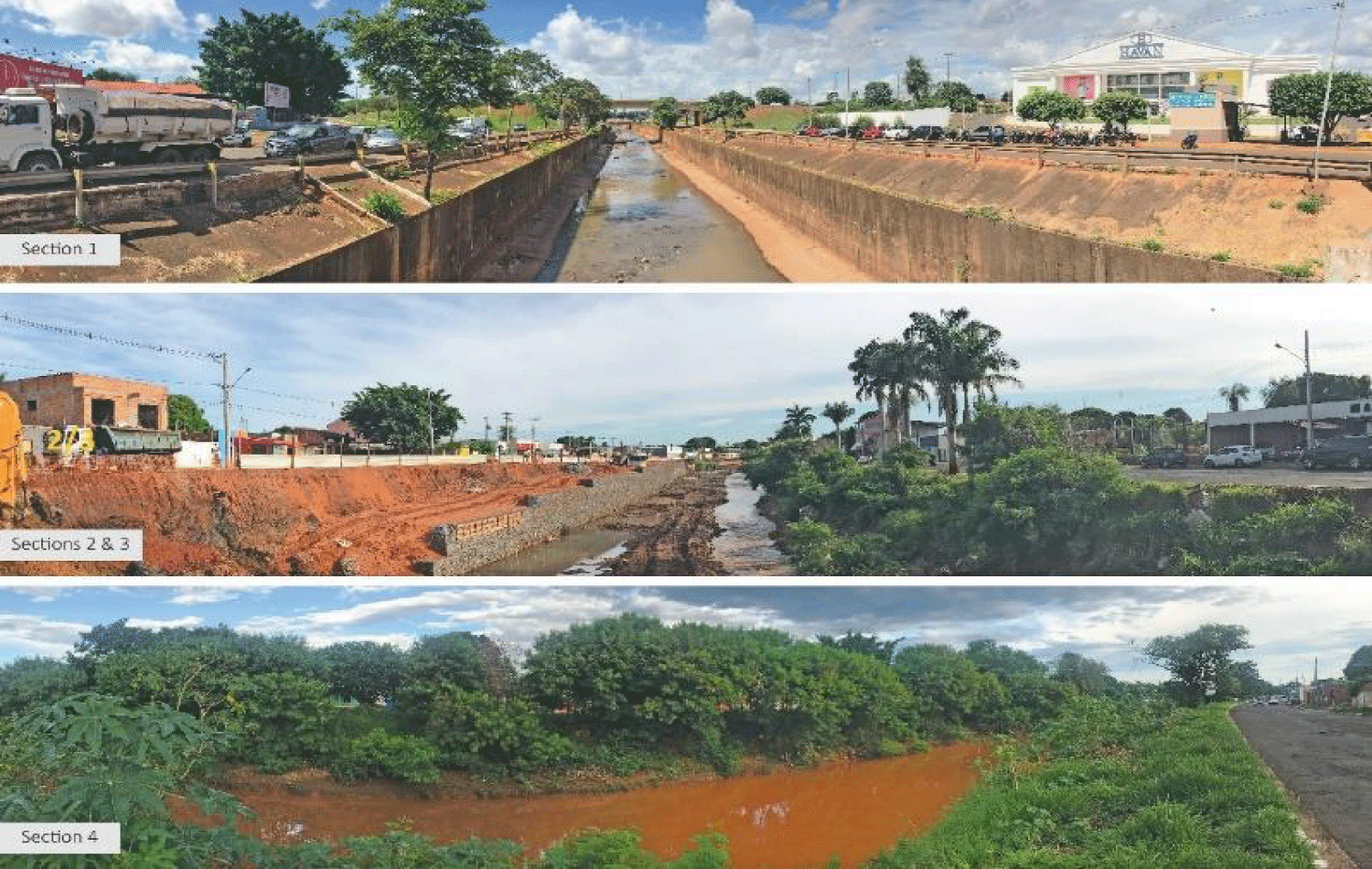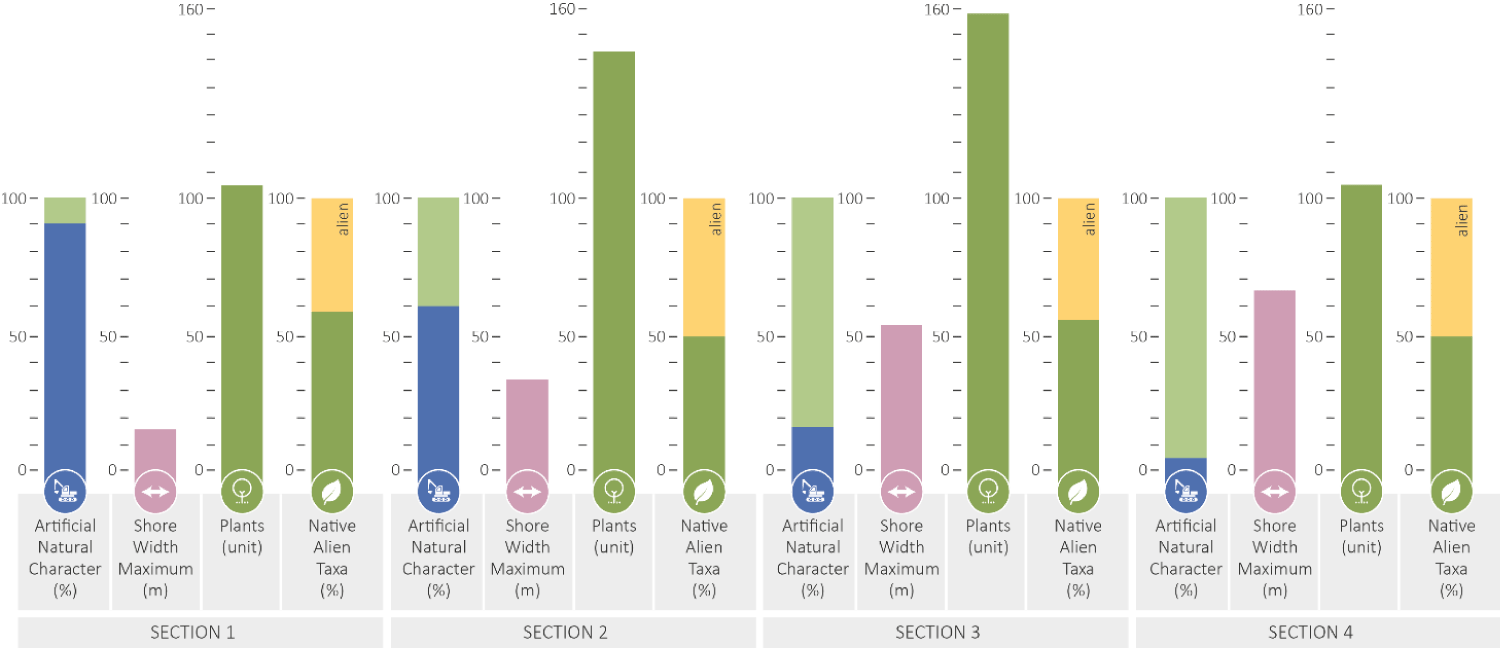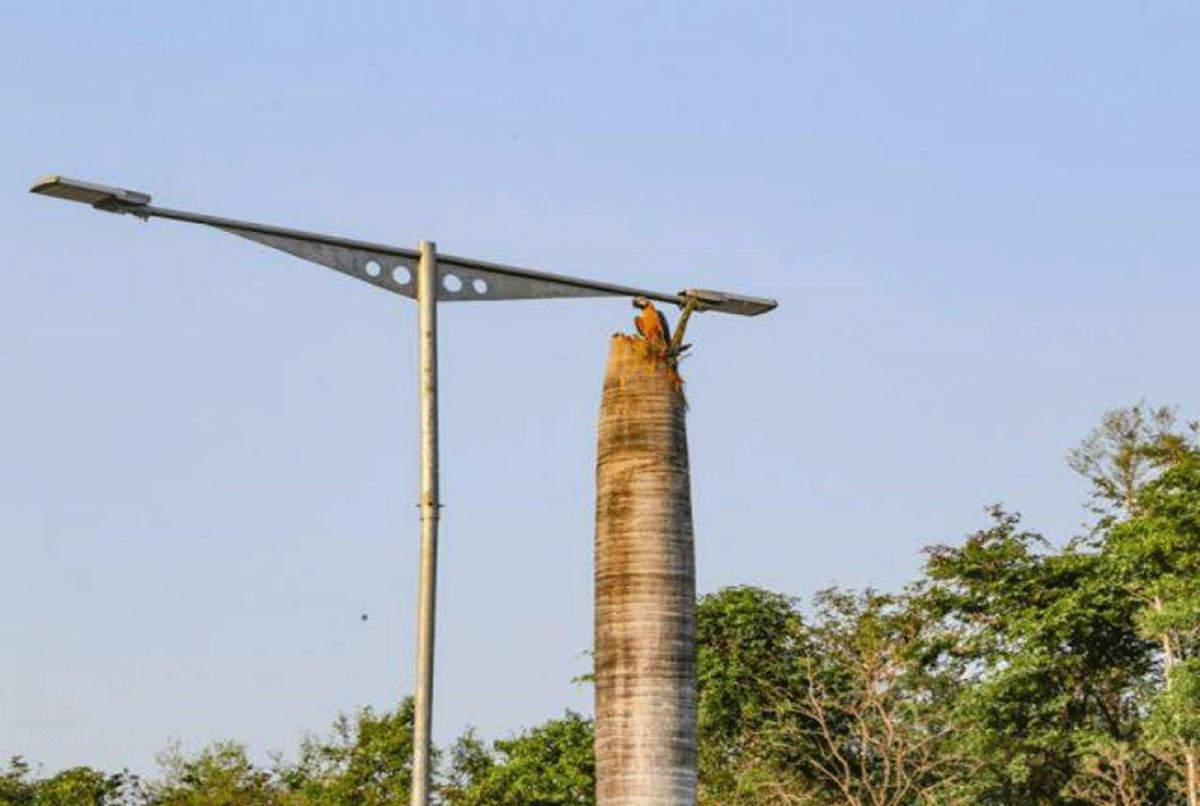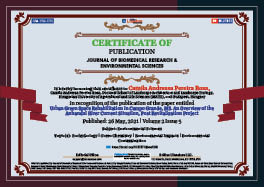> Environmental Sciences. 2021 May 26;2(5):399-405. doi: 10.37871/jbres1248.
-
Subject area(s):
- Ecohydrology
- Green Chemistry
- Environmental Impacts
- Environmental Contamination
Urban Green Space Rehabilitation in Campo Grande, MS. An Overview of the Anhandui River Current Situation, Post Revitalization Project
Camila Andressa Pereira Rosa2*, Gabriel Silva Dantas1 and Bárbara Mylena Delgado da Silva2
2Doctoral School of Landscape Architecture and Landscape Ecology, Hungarian University of Agriculture and Life Sciences (MATE), 1118 Budapest, Hungary
- Urban health
- Urban greenery
- Landscape planning
- Project analyses
Abstract
Research has shown that Urban Green Spaces (UGS) can have a direct impact on urban health and well-being, being able to help combat urban ill and improve life quality. This short paper presents an investigation of the importance of urban greenery and how it can benefit life in the urban environment. Furthermore, it analyses the current situation of the Anhanduí river, located in the Brazilian city of Campo Grande - MS, after the revitalization project from 2018. Based on relevant literature review and systematic field assessment realised in person in January 2019, this review aims to identify if the main issues (erosion and landslide, flood control and water quality, lack of ecological, visual and functional connections, ecological degradation, loss of identity and native vegetation) encountered in the earlier research were properly solved. Preliminary evaluations indicated severe neglect at the river’s riparian zone, thus immensurable loss of original vegetation and delay in the construction sites.
Introductıon
Cities are becoming congested and polluted in an ever-increasing pace [1], due to the unremitting and disorganized urbanization process. According to the study published by the United Nations’ Department of Economic and Social Affairs (UN DESA), in 2018 “55% of the world’s population lives in urban areas, a proportion that is expected to increase to 68% by 2050” [2]. It has been proved that Urban Green Spaces (UGS) can impact the environment and well-being in urban centres, such as with the improvement of air quality, decrease in temperature and overall positive impact to daily life and wildlife habitat [3,4]. Despite the fact that these statistics keep growing, a considerable number of research attention has been directed towards the affair of urban greenery (green spaces, greenways, urban forests, promenades, etc.) due to their fundamental role in the urban landscape, health and well-being [5,6]. Furthermore, some research shows that greater biodiversity in such spaces can greatly increase the psychological benefits of UGS [7]. Additionally, according to the EU Water Framework Directive, river restorations can promote healthier and more resilient ecosystems, as well as improve water quality, thus improving wildlife habitat conditions.
In this perspective, in January 2019 a thorough site analyses was conducted by the academic in order to assess the condition of selected areas of the Anhanduí river, located in the Brazilian city of Campo Grande. Based on relevant literature review concerning greenways and river restoration, the research focused on proposing a greenway for the site, aiming to contribute to the existing urban planning guidelines that lacked knowledge on how to manage watercourses with greenway strategies. The main scope of the research was to contribute to the local literature that lacked specific studies in the area, both in regards of landscape planning and vegetation assessment. Moreover, even though the city was developed between two streams known as Prosa and Segredo, with the purpose of occupying the tabular forms of the lands with an orthogonal plan, in chess, with wide east-west streets, the hydrology of the land was later treated as a problem and most watercourses were channelled [8].
Furthermore, the study also addressed six main serious issues identified on the site, them being erosion and landslide, which had become a serious issue due to the rain seasons combined with the municipality’s neglect; current flooding, since due to environmental changes seasonal floods have been occurring in a crescent frequency, being also a result of bad shore engineering and the decrease of active surfaces; lack of connections (ecological, visual and functional); ecological degradation, caused by years of neglect and deforestation; loss of identity and strategies to improve ecological values and greenery level.
During the site assessment it was noted that parts of the river have been under construction, based on a revitalization process dated from 2011 but that only started in 2018 [9]. Due to this fact, some analysed areas had already lost their original character and vegetation. Owing to that, after the research was concluded and the results presented as part of the academic’s Master’s diploma, further questions were raised as the revitalization project was ongoing. For this reason, further research was and still is needed in order to assess the current situation of the site, to both understand if the issues were addressed properly and try to identify the efficacy of the revitalization project. In order to do so, another in person site visit and assessment was conducted by the academic in January 2021. The revitalization project of 2018 main focus is flood control, hence the importance of this research, which lies on the fact that little attention has been directed towards the importance of landscape planning by professionals of the field, and potential habitat rehabilitation.
The 2019 research
The methodology consisted of a pragmatic approach based on international and national literature review, qualitative field assessment and usage of landscape architecture planning principles and strategies, data collection and an exploratory analytical research of the city of Campo Grande. Following, the execution of specific site analysis in the Anhanduí river, performed in person in January 2019, utilizing a field assessment form elaborated by the academic. Due to the length and different profile of the selected area, the site was divided into four sections (Figure 1), together with the urban context it is inserted. Afterwards, those sections were subdivided according to the number of bridges and character it presented, leading to a total of twelve subsections, envisioning the facilitation of data collection and assessment.
In order to achieve the expected results, a test criterion was developed by prioritizing pre-evaluation elements to be studied in order to serve as a basis for a deeper and more detailed plant application analysis. In this perspective, the points to be taken into consideration were the evaluation of the character, green surface elements, plant species, diversity, maintenance and plant profile. This collected material would support further research on the subject, resulting in the ability to elaborate proposals and guidelines for landscape planning and greenery enhancement.
Urban overview
Campo Grande is the capital city of Mato Grosso do Sul, one of the 26 states in Brazil, counting with an estimated population of 2.809.394 people in the whole state [10]. Located in the Midwest part of the country, the city consists of 8.092,5 km² in territory, from which 154.5km² corresponds to the urban area. For means of reference, the size of Budapest corresponds to only 6.49% of Campo Grande. However, the Hungarian capital has a total of 1.752 million inhabitants [11], whereas Campo Grande has an estimate of 906.092 [12], though with the potential to house 4 million people [13].
Regarding the vegetation typology, Campo Grande belongs in the neotropical zone in the domains of the Cerrado phytogeographic region, constituting a set of vegetation forms that are presented according to a biomass gradient, directly related to soil fertility. The main physiognomies of this vegetation forms are the Campo Limpo, Campo Sujo, Cerrado, Cerradão, in addition to the presence of the Alluvial Forest (riparian forest) and areas of ecological tension, represented by the contact between the Cerrado (Seasonal Semideciduous Forest) and areas of anthropic formations used for agriculture [14,15].
The Anhanduí river is the biggest watercourse crossing the city in a NE/SW direction. The river spring is situated in the Northeast of Campo Grande, flowing to the Southwest until the end of the urban perimeter and deeper into the MS state. The selected area for this study corresponds to approximately 6.2 km of the water body, starting from Afonso Pena Avenue, going through Ernesto Geisel Avenue and stopping at Ezequiel Ferreira Lima Avenue. The width of the site varies from 17 to 70 meters approximately, including the riparian zone, and this variation is due to the urbanization process and construction of the roads. This section is situated between the two existing Anhanduí Ecological parks, besides being an area with abundant research potential, thus it was chosen for the present study.
In its initial history the river was used to provide water for human consumption, cattle breeding, irrigation of crops, fishing and recreation. With the city’s development the river no longer served those functions, but rather started being treated as sewage drainage, action that led to major ecological damages. As a result of the ever increasing and disorganized urban sprawl that have been occurring for the past 60 years, the character of the river changed completely, going from around a 95% natural environment to an almost 100% artificial character, with engineered, man-made concrete structures and none of the original character left [16]. Overall, it is possible to say that the existing site serves as a traffic way, heavily used and of extreme importance to the road structure.
Findings and conclusions
As a result of the preliminary research of the green spaces at the proposed site, focused on the riparian area of the river, both private and public ownerships could be found in the area, the majority being publicly owned land, especially alongside the watercourse. Among them, there are two Anhanduí Ecological parks, a historical square, two sports fields, an ecological protected area belonging to the Federal University and small irregular ‘private’ gardens claimed by the citizens in publicly owned land in the riparian zone. Furthermore, approximately seven unused lots could be identified in the close surroundings. They vary in size and character, and unfortunately, the reality is that most of the parks and squares in the surroundings are not properly maintained, becoming unsafe places [17,18]. In concerns of the existing ecological scenario, it can be described as precarious with improper plant application and maintenance. The riverbed and riparian zones are degraded presenting many erosion spots, discarded litter near and inside the water, water pollution and destruction of habitats. Additionally, in many parts, especially in sections two and three, almost all the original vegetation was cut due to an ongoing engineering project to rebuilt and create new retaining walls.
The Anhanduí river surroundings can, in some level, be considered an important ecological place in this regard, even though the urbanization process damaged the ecological balance of the area, some species can still be seen in some parts of the site. Even though the water is polluted, some fish (Tilapia, Cyprinus carpio, Loricariidae) species can still be found in the shallow waters, as well as various birds, tortoises (Chelidae species) and capybaras (Hydrochoerus hydrochaeris).
Further analyses showed that the character of the river and surroundings changes throughout the selected part, having the character of a men-made, channelized river, in section one, seeing that the shore and river bottom are concreted structures, leaving little or no place for vegetation or bare ground. Moving towards sections two, three and four further away from the city centre, this character gradually changes into a more natural or nature-like feeling, with the artificial structures decreasing and more vegetation appearing, which can be already noticeable with the cooling in temperature.
At this stage, resulting from the site assessment it can be stated that the profile starts with predominantly man-made structure resulting in an approximately 90% artificial character in section one, due to the concrete engineering structure covering the entirety of the river bottom, bed and most of the riparian zone, whereas section two is approximately divided in a 60% - 40% ratio of man-made and natural surfaces. On the other hand, section three could be described as 85% natural and section four as having approximately 95% natural, containing only a few old concrete small retaining walls hidden among the vegetation, besides the steel concrete structures underneath the bridges. Even though these proportions were not calculated with specific mathematic formulas, the overall conclusion is that in a Southwest direction, the artificiality of the river decreases, meaning that the closer to the city centre, the more artificial the character gets, in contrast to the naturality still existing in opposite direction (Figure 2).
During the evaluation of the first section 106 plants were recorded. The species that could be identified consists of eleven native taxa (Albizia hassleri, Areca genus, Allamanda schotti, Caesalpinia pluviosa, Ceiba speciosa, Licania tomentosa, Pachira aquatica, Psidium guajava, Syagrus romanzoffiana, Tabebuia spp., Tecoma stans) and seven alien taxa (Agave americana, Mangifera indica, Nerium oleander, Lagerstroemia indica, Leucaena leucocephala, Terminalia catappa, Yucca aloifolia). In section two 145 plants could be accounted for. Six being native taxa (Albizia hassleri, Areca genus, Cassia grandis, Inga laurina, Syagrus romanzoffiana, Tabebuia spp.) and six alien taxa (Albizia lebbeck, Cananga odorata, Ficus benjamina, Leucaena leucocephala, Ricinus communis, Roystonea oleracea) could be identified. Furthermore, the Inga laurina has a great value as a fruit tree and could be seen being enjoyed by both humans and birds. In section three 159 plants could be counted, where five were native taxa (Albizia hassleri, Ceiba speciosa, Inga laurina, Syagrus romanzoffiana, Spondias mombin) and four were alien taxa (Leucaena leucocephala, Roystonea oleracea, Ricinus communis, Syzygium cumini) could be classified. This section presented most of the previous section (section two) characteristics, therefore the same plant aspects could be observed here (Figure 3). Even though the complete assessment and characterization of plant application could not be 100% precisely concluded, it is viable to affirm that there are many alien species and aggressively spreading plants, which raises the need for further research.
The upshot of these results is the possibility that future work will concentrate on investigating the small details and characteristics of each specific green space presented on this paper, focusing on the precise analysis of the plantation after the end of the shore engineering project. Additionally, it highlights the need for further improvement on the water quality monitoring and treatment, in order to successfully restore the habitats. Afterwards, with the results obtained (e.g. plant profiles, patterns, use, condition, problems and solutions), it will be possible to extend the research to the streetscape, urban fabric to, finally, reach the whole cityscape. Moreover, this research acknowledged the presence of various edible and familiar fruit trees not being relished as such, thus endorsing future plant application study centred in fruit trees in the urban environment and the impacts caused by pollution.
The revitalization project of 2018
The water engineering project aimed to built retaining walls in the riparian zone of the Anhanduí river at the Ernesto Geisel avenue, concreting almost the whole area and not giving much thought to landscape planning design whatsoever. The exception to this strategy was just some small areas selected to have some kind of sitting areas, in addition to pedestrian pathways in some parts. Due to older channelling projects realised in the rivers and streams of Campo Grande and disordered occupation, this area has been suffering for years with erosion, landslide and floods [18]. The project is a partnership between the State Government, the City Hall and the municipality, which was able to unlock R$180 million (approximately €42 million) in resources for infrastructure works in the capital. The program, called ‘Together for Campo Grande’, started in April 2018 and includes the revitalization of the 7.5 kilometers of the Anhanduí river bank, with the construction of gabion walls and concrete slabs, the implantation of a bicycle lane, the construction of gullys to capture the flood water and the reconstruction of the avenue.
The project had been stalled since 2011 and ran the risk of having federal resources lost for lack of action [19]. Divided into three parts, the first two steps have a deadline of 18 month, whereas the third part must be completed within 30 months, leading to an expected finishing date in October 2020. Moreover, other aims of the project are the construction of rain gutters, wetland recovery, flood damping reservoir, complementary urbanization and paving. Some of the vegetation, such as the old palm trees, are to be taken from the river and replanted in other parts of the city [20].
The situation of the Anhandui river in 2021
Even though the municipality predicted to finish the construction by October 2020, the project got delayed due to bad weather, lack and/or delay of funding, bureaucracy to request further funding from the Federal Government, among other reasons. In July 2020 the headperson of the Municipal Secretariat for Infrastructure and Public Services (Sisep) announced that they should finish the project by the city’s birthday on the 26th of August 2021 [21]. However, the municipality already announced that there were further delays in the construction, and their new estimation is sometime in 2022 [22].
Regarding the greenery, most of the vegetation was cut from the river’s riparian zone in order for the engineering project to proceed. Even though the project consisted of replanting and restoring the green spaces, the site is still lacking vegetation. Beside the ecological and aesthetical values, this can be considered a big issue going contrary to the project’s intention to retain floods and prevent landslide and erosion, seeing that vegetation can help prevent such occurrences [23]. Additionally, some plants were cut from the site and allocated to different parts of the city, mainly palm trees that were replanted along the Fadel Yunes avenue. Unfortunately in September 2019, one year after being replanted, around 10 trees had already rotten and were dying. On the other hand, while they are still standing they are being used as a nest for several macaws that live in the region, and like to nest in such hollow trees (Figure 4). Other specimens were planted in the Arquiteto Rubens Gil de Camilo avenue, where they also show signs of decay. According to the biologist Marco de Barros Costacurta, their death and deterioration are probably associated with the transplantation from the river shore to their new location [24].
Another important occurrence that could be observed in the Anhanduí river is the suffering of fauna, more specifically the fish. Owing to the pollution of the river and the endless construction project going on and off since 2018, in August 2019 a school of fish, probably Tilapia, Cyprinus carpio, and/or Loricariidae species [16], was seeing agglomerated and gasping for air near one of the water ducts of the river [19,25]. Later that same year, citizens reported the unusual colour and smell of the water, which they later saw had tons of dead fishing floating and in the river shore. Water samples were collected and sent to the laboratory for further testing, in order to identify further causes for this sudden ecological disaster [26].
Discussion
We live in a world where the need for urban green spaces rehabilitation has become a recurrent topic. By reinstating healthy habitats, we can increase urban health and well-being. For this reason, the first steps towards enhancing the environmental values of Campo Grande’s green spaces started in 2019, with the research of the Anhanduí river and its surroundings. The findings shed light in the main pressing issues regarding the shore hazards, water management problems, ecological degradation and others. In addition, it showed abounding improvement possibilities present in the site. Moreover, resulted in new questions regarding the future situation as well, owing to the ongoing shore revitalization project.
By comparing the data analysed in 2019 and the new research findings from January 2021, hence the evolution of events that took place in the site until present days, it is feasible to say that the delays in the reconstruction has been increasing the ecological damages on the river. To mention one, the shoal death that has happened due to lack of oxygen in the water. In addition to that, experts are still running lab tests to identify further reasons for such major ecological disaster. Moreover, the deforestation of native vegetation that happened in the river’s shore in order for the revitalization project to occur, still has not been reverted, as proposed. The riparian zones affected are still “naked” of vegetation, which can contribute to further landslide, since it has been proved that vegetation can help avoid such occurrences.
Furthermore, it is viable to affirm that a proper landscape planning strategy is needed in order to restore the habitats in an active way, in the urban environment of Campo Grande. Having only the shore engineering project is not enough for such an important green corridor of the city, and other factor should be taken into consideration for the proper ecological restoration. The essentiality of a proper plan and execution is crucial, and the lack of such and the ever-increasing delays in construction has been raising the ecological damages to the site. It is necessary to stop and examine what processes have led to the current situation, exclude and modify factors in order to create valuable and stable sustainable green spaces and reintegrate the Anhanduí river to the urban fabric, as a healthy and functioning habitat. Further research is still ongoing and it aims to bring together a multidisciplinary professional team and the municipality, in order to enhance the strategy currently in place, seeking to bring greater awareness to all the issues already mentioned and further ones that may appear.
References
- Blanco H, Alberti M, Forsyth A, Krizek KJ, Rodriguez DA, Talen E, et al. Hot, congested, crowded and diverse: Emerging research agendas in planning. Progress in Planning. 2009;71:153-205. doi:10.1016/j.progress.2009.03.001
- United Nations, Population Division of the United Nations Department of Economic and Social Affairs (UN DESA). 2018. https://bit.ly/2RMrcY3
- Scott C. A brief guide to the benefits of urban green spaces. University of Leeds. 2015.
- Nowak DJ, Dwyer JF. Understanding the benefits and costs of urban forest ecosystems in Urban and community forestry in the northeast. Springer, Dordrecht. 2007;25-46. doi:10.1007/978-1-4020-4289-8_2
- Endreny T, Santagata R, Perna A, De Stefano C, Rallo RF, Ulgiati S. Implementing and managing urban forests: A much needed conservation strategy to increase ecosystem services and urban wellbeing. Ecological Modelling. 2017;360:328-335. doi.org/10.1016/j.ecolmodel.2017.07.016
- Lohr VI, Pearson-Mims CH, Tarnai J, Dillman DA. How urban residents rate and rank the benefits and problems associated with trees in cities. Journal of Arboriculture. 2004;30(1):28-35.
- Fuller RA, Irvine KN, Devine-Wright P, Warren PH, Gaston KJ. Psychological benefits of greenspace increase with biodiversity. Biology letters. 2007;3:390-394. doi.org/10.1098/rsbl.2007.0149
- Junior A. Plano de desenvolvimento integrado do Município de Campo Grande. ARCA 14. 2009;63-64.
- TV Morena. Obras de controle de enchente no rio Anhanduí, em Campo Grande, começam após 6 anos. G-1 Globo.com 16 April 2018. 23 May 2021. https://glo.bo/3wx2ABb
- IBGE. Censo Demográfico, Arborização de vias públicas. Campo Grande. 2010.
- Hungarian Central Statistical Office. Population by type of settlement – annually. May 2021. https://bit.ly/3hMDN8e
- IBGE. Panorama. Campo Grande. 2020. 13 May 2021. https://bit.ly/2SsUTNz
- Arruda A. Entendendo os vazios urbanos de Campo Grande MS. Vitruvius. January 2019. https://bit.ly/2Td9NYN
- Neto GG, Guarim VLM, Prance GT. Structure and floristic composition of the trees of an area of cerrado near Cuiabá, Mato Grosso, Brazil. Kew Bulletin. 1994;499-509. doi.org/10.2307/4114474
- Eiten G. The Cerrado Vegetation of Brazil. The Botanical Review. 1972;38:201-341. doi.org/10.1007/BF02859158
- Rosa CAP. Anhanduí Linear Park. A greenway proposal for the city of Campo Grande. Diploma thesis. 2019. https://bit.ly/2RJnbDG
- Safety and Security - Brazil Travel Advice. n. d. GOV.UK. 2021 May 6. https://bit.ly/3hWvt5N
- Voos CH, Cattani AD. Social Agents, State and Urban Planning in Brazil: New Theoretical and Methodological Perspectives after the City Statute. RC21 International Conference on The Ideal City: between myth and reality; Italy. 2015. https://bit.ly/3umjX6l
- de Souza PN. Prefeitura abre licitação para obras em três trechos da margem do Anhanduí. Campo Grande News. 10 May 2021. https://bit.ly/34j1PQ6
- Chianezi M. Palmeiras serão retiradas da Ernesto Geisel para serem replantadas em bairro de Campo Grande. Midiamax. 12 May 2021. https://bit.ly/3bSpwmN
- Albuquerque D. Ernesto Geisel deverá ser entregue no aniversário da Capital de 2021. Correio do Estado. 12 May 2021. https://bit.ly/3wABjOb
- Chianezi, M. Chuva dá trégua e obras na Ernesto Geisel são retomadas; serviço terminará em 2022. Midiamax diário. 13 May 2021. https://bit.ly/3oQhIas
- Donat M. Bioengineering Techniques for Streambank Restoration A Review of Central European Practices. Watershed Restoration Project Report. 1995.
- Neris G. Um ano após serem replantadas, palmeiras apodrecem em avenidas. Campo Grande News. 13 May 2021.
- Jara T. Em busca de oxigênio, peixes agonizam no Rio Anhanduí. Campo Grande News. 14 May 2021. https://bit.ly/3ueOJy5
- Oliveira V, Palheta F. Semadur investiga mortandade de peixes no Rio Anhanduí. Campo Grande News. 14 May 2021. https://bit.ly/3hOsLiM
Content Alerts
SignUp to our
Content alerts.
 This work is licensed under a Creative Commons Attribution 4.0 International License.
This work is licensed under a Creative Commons Attribution 4.0 International License.





